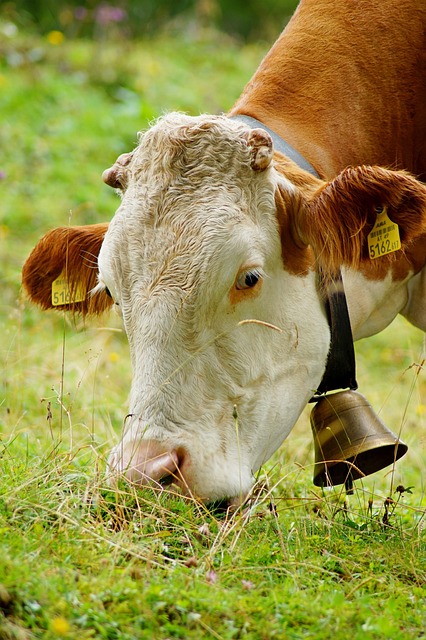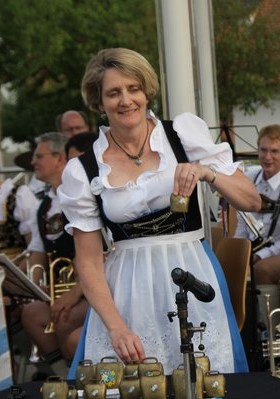It’s that time of year. You smell brats on the grill. You taste pretzels and malty beer. You feel a refreshing breeze.
Uh, scratch that last part. No cool breeze makes its way to North Carolina in September. But somewhere, some place, the air is turning cooler.
And then there’s that sound. Faint at first, then ringing bright and clear. It’s unmistakable. The sound of cowbells.
Cowbells, not like the Saturday Night Live More Cowbell skit. Cowbells like in More Cowbells, with an s, as in multiple bells. Like the bells that European cows actually wear.
These particular cowbells, however, are accompanied not by cows, but instead by traditional German garb – men in lederhosen (leder=leather, hosen=pants) and women in dirndl (pronounced deerndl not durndl). Garb appropriate for the schuhplattler, a dance traditionally performed by men slapping their thighs and shoes. Nowadays women take a turn as well. Anyone who scoffs that women are ruining the tradition should try to schuhplattle wearing a skirt and heels. In fact, everyone should try it. It’s a great party trick. Don’t worry, you can have a beer first, though best not to have too many.

But getting back to the cowbells.
For centuries, the tradition enabled farmers to locate cows that went astray in the pasture. Big bells with low notes for the big cows and bulls. Small bells with high notes for the small ones who wend themselves into tiny nooks and crannies.
At some point along the way, cow herders removed the bells from the cows, lined them up in order and played melodies with them. The bells, that is, not the cows.
They’re called Kuhglocken (pronounced koo-glockn) or Alpenglocken or sometimes Almglocken after alpine meadows. You might have seen a single bell painted with alpine flowers on display on a Christmas tree or in a tourist shop.
Each song uses different notes, so the Kuhglockenspieler (cowbell player, i.e. me) lays out the 10-15 bells required for that piece in a prearranged pattern. The layout is designed to maximize the ease of picking up bells in alternating hands without turning into a pretzel. It requires practicing until the pattern is baked into muscle memory since the F bell is not where it was in that last song. This can take years. Imagine if your piano keys moved around for every song.
By the way there’s an H bell, which if you remember anything at all from elementary school music class, doesn’t exist. The H bell really is a B, and the bell labelled B is a B flat. Don’t ask, but this post delves into theories.
Despite the tradition in the fields and the yearly ceremonies, there is a growing movement that such bells harm the cows. Cows apparently don’t like the weight or the sound of metal clanging.
I get it. Have a listen. How would you like a 12 pound bell around your neck that rings as loud as a chain saw at your every move? Or every move of your neighbor Bessie?
The practice has also led to calls to eliminate the tradition, court cases by neighbors who can’t sleep, scientific studies to evaluate the impact on cows, and even the denial of Swiss citizenship to a woman who allegedly cared more about cows than the country’s traditions.
Here in the US, specifically in The Little German Band and Dancers, you can rest easy. No cows were harmed by the cowbells that found their way to North Carolina.
Damaged eardrums, perhaps, especially if you get too close. The ego of the Kuhglockenspieler, absolutely, when she haphazardly knocks a bell to the floor during an exuberant rendition of Edelweiss. The pride of a 2 year old, definitely, when he toddles up to the table and is promptly scolded for wandering off with one or two bells. (Sorry buddy, I need all 21 bells. They are a matched set!)
But no cow damage.

The goal of the bells is merely one thing. Gemütlichkeit. You know, that feeling of warmth and camaraderie you get hanging out with friends over good food and good music.
To soak in some Kuhglocken and Gemütlichkeit, check out me and my fellow ringers at a performance of The Little German Band and Dancers.
I assure you that no cows will protest.
Prost!
